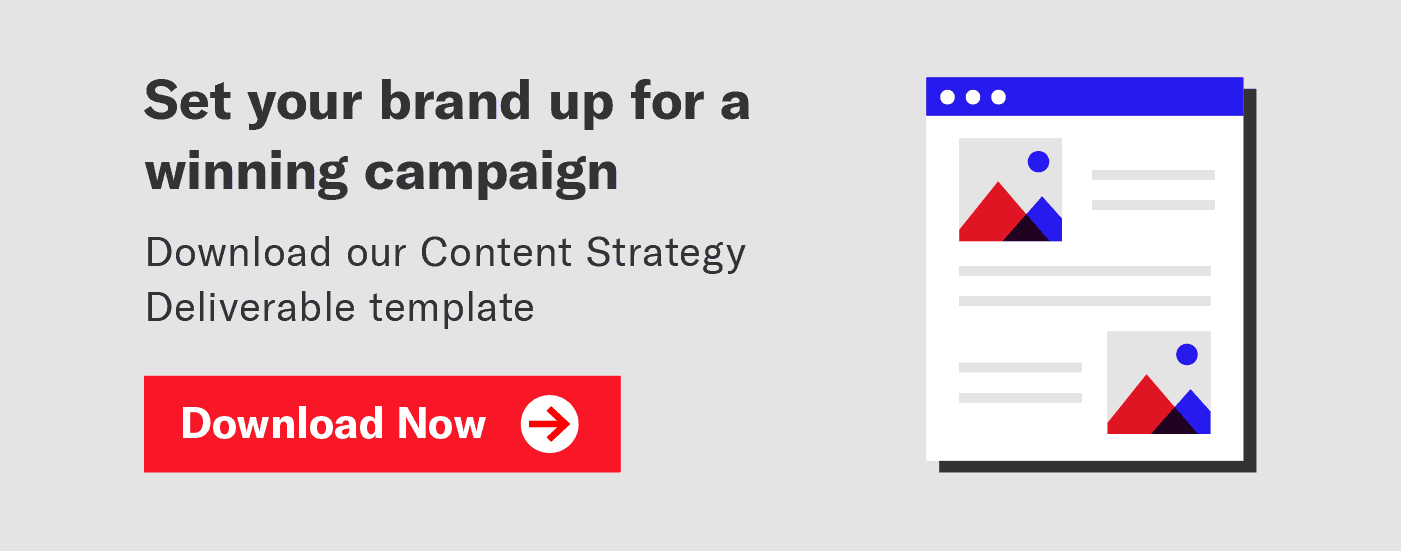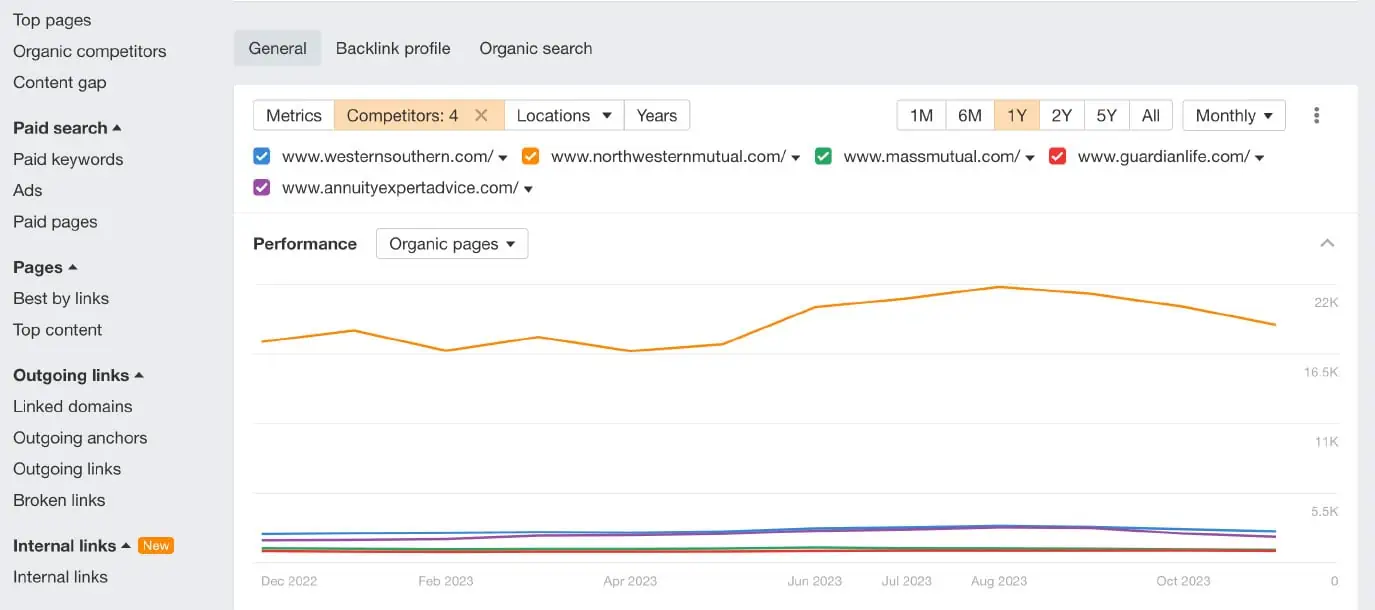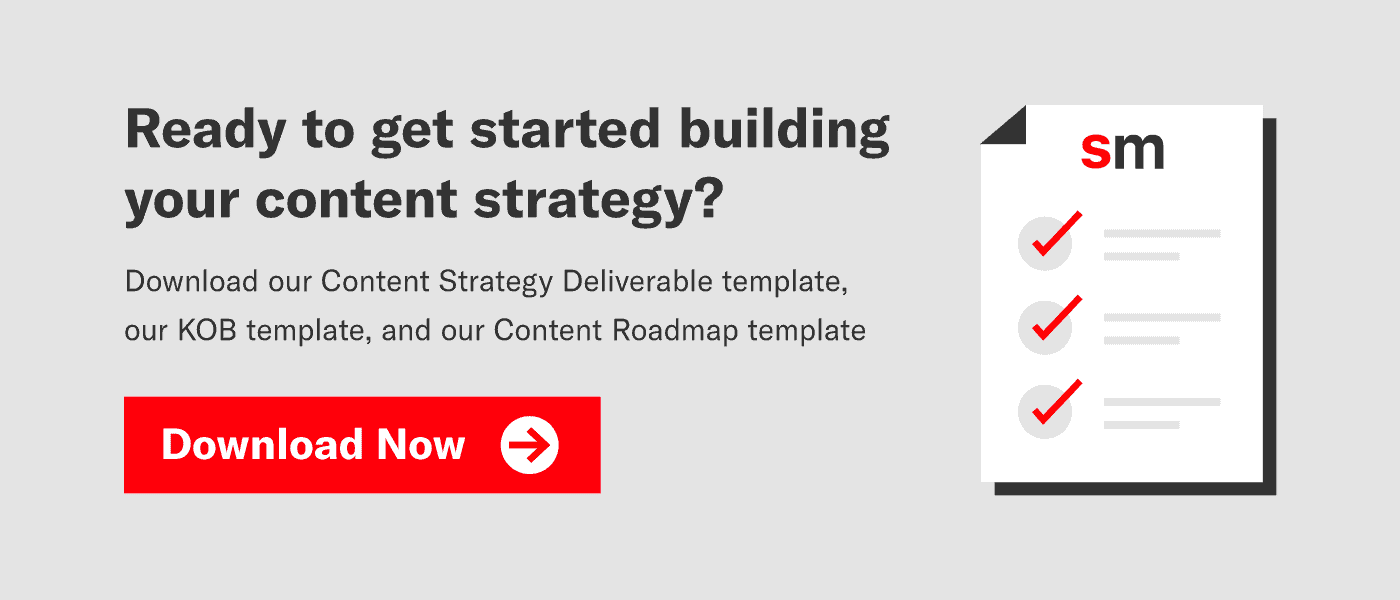Want to know what it takes to kick off content strategies at scale? At Siege, we’ve developed three core content strategy templates that help us launch successful campaigns for brands across industries with minimal friction.
Scaling your content efforts can feel daunting because there isn’t an established formula for success — until now. We created templates so you can kick off a successful content marketing campaign.
Read on for tips on creating a winning content strategy and the templates you can use to facilitate a successful campaign.
Already know what you’re looking for? Download our content strategy templates below:
- Content Strategy Deliverable Template
- Keyword Opposition to Benefit Analysis Template
- Content Roadmap Template
Create a Content Strategy Deliverable
When kicking off a new client engagement and building a content strategy, the first document we suggest creating is a Content Strategy Deliverable. This document serves as exploratory research that sets the stage for keyword research and overall content planning. It also serves as the foundation for all other strategic documents we create in the first month of a typical client engagement.
To build a successful Content Strategy Deliverable, you’ll want to look at the overall competitor landscape and how your brand fares comparatively. You’ll also want to evaluate your overall site’s health and trustworthiness, as this will indicate your ability to rank for key terms. Finally, consider your brand’s unique voice and value proposition.
In a crowded marketplace, successfully capitalizing on what makes your brand unique — and how you solve your customers’ problems — will help your content stand out.
Keep reading for the core elements to remember when building your Content Strategy Deliverable below.
Perform Competitor Research and Market Analysis
Performing competitor research is an important first step when building your content strategy because it allows you to evaluate the current competitive landscape — and how your brand stacks up.
By evaluating what’s working for competitors and analyzing existing gaps in their strategy, you can capitalize on key opportunities to build a winning content plan.
We recommend taking qualitative and quantitative approaches to competitor analysis. Tools like Ahrefs and Semrush allow you to quickly discern how you fare against others in your industry so you can be data-driven when determining your content mix. You’ll also want to spend time evaluating your competitors’ current content inventory to determine strengths and weaknesses of their existing strategy — and identify ways you can ensure your approach is at least 2X better than what’s already out there.
Some of our favorite ways to use SEO tools for competitor research include:
- Checking out Ahrefs’ Competing Domains Report: Quickly glean how you compare to your competitors from a traffic, link, and rankings perspective.
- Evaluating SemRush’s Competitive Positioning Map: See a visual representation of how you stack up against competitors — and potentially even identify new rivals to evaluate in the process.
- Looking at Ahrefs’ top trafficked posts and top posts by links: This will show you what topics your competitors currently own and help you ideate potential organic link topics to go after.
- Manually searching Google for the target terms you’re most interested in winning: This will show you who’s consistently ranking for your highest value phrases and will provide initial guidance on what you’ll need to do to compete in both content and site architecture.
Once you’ve identified a couple of key competitors, do a deep dive into their content strategy and site experience. What do you like about navigating their website? Is it intuitive to find what you’re looking for? Does their content include imagery, creative uses of HTML, or data visualizations? How long is the typical post? Are there any themes in what types of content are performing the best?
By evaluating patterns in competitor content and site architecture, you can build a plan for your content mix and identify site-wide tweaks essential to strong performance in your industry.
Assess Site-Wide Opportunities
Content strategy doesn’t happen in a vacuum. To ensure successful campaign performance, think about the overall health of your site and if any technical limitations might hold you back.
A few things to consider include:
- Where will your content live? Do you need a blog or learn center? Typically, learn centers are best for brands with long sales cycles where prospects need lots of product and industry knowledge before purchasing. If you’re a B2B brand, you may even want to consider investing in both, as they’ll serve different users in different stages of the buyer’s funnel.
- Is your content easy for Google — and users — to find? Once you’ve identified the best content hub strategy, make sure it’s internally linked in easy, high-priority places like the top navigation bar to ensure search engines and readers can quickly surface what they’re looking for.
- Do your blog categories align with buyer personas? We find that organizing content in this manner makes it easier for users to find the content that best solves their problems and encourages longer time on site, a positive ranking factor.
- Does the site as a whole inspire trust? While this isn’t exactly a scientific metric, put yourself in the shoes of a user landing on your page. Be honest about the overall experience and what you can optimize.
Too close to your brand to be objective? Working with an agency partner or internal stakeholders who are less in the weeds with your existing content strategy can help provide a fresh perspective.
Dialing in your internal linking strategy across your site is also crucial to ensuring the success of your content from a rankings and organic link generation perspective. In addition to making sure your blog or learn center is linked in the top navigation, you’ll also want to make sure each post on your site includes at least five links to other articles on your site.
Tip: Got high priority pages that you’re trying to boost rankings for? Add them to your top navigation to nudge their place on the SERPs.
Evaluate Your Brand and Value Proposition
Creating a Content Strategy Deliverable provides you with the opportunity to get clear on what makes your brand unique and how you can capitalize on this to build a winning content strategy. This is your chance to get crystal clear on your mission, target audience, brand voice, and the brand personas that your content will target.
Most companies have existing documentation as a reference, so you’re not building this information from scratch. Get creative referencing your company’s marketing and sales resources if they are available. Even if you do have existing documentation covering your brand and value proposition, the clarity gained by adding this information to your Content Strategy Deliverable can be invaluable to understanding your brand before you start creating content.
New to creating personas for your brand? If you’re lacking existing resources to pull from or looking for assistance with building out your brand identity, you can use Chat-GPT to quickly create a starting point you can build from.
As you perform competitor research and start building your strategy, start thinking about what the ideal mix of content will be to best meet your company’s goals. Are you a new brand looking to build general awareness? If so, focusing on top-of-funnel content may be best for you. Already have existing traffic but looking to increase qualified leads? You’ll likely want to build a campaign focused on mid- and bottom-funnel content that will help you maintain traffic and increase conversions.
If you are a lifestyle brand, you may notice the big players in your industry are creating top-funnel listicles, while SaaS brands focus on conversion-driving assets like eBooks, templates, and downloads that will capture emails and move users through the funnel. Evaluate what’s working and think through what mix of content will help your team best accomplish your goals.
While you will gain an initial idea of types of content common in your industry by performing competitor research, you can also conduct keyword research to ensure you have the best mix of topics for your content plan. We’ll dive deeper into the best approach as we explore templates two and three!
Create Punch List of Priority Projects
The last step of creating your Content Strategy Deliverable is to create a list of priority projects that will be crucial for your team to accomplish to hit your goals. While good content is key, it’s also essential to set your site up to allow you to hit your goals.
Making a quick punch list of the next steps — and identifying who’s responsible for implementation — will help hold your team accountable for making progress on high-impact projects like blog tweaks, internal linking, and technical SEO work that will impact overall performance.
Conduct KOB Research
The second template we suggest leveraging when building your content strategy is for Keyword Opposition to Benefit (KOB) Analysis. This template helps facilitate deep keyword research while also providing a prioritization system that will set your campaign up for success.
Once complete, the KOB will provide your team with clarity on what topics to tackle first by prioritizing queries based on low keyword difficulty and high traffic potential.
Already have existing keyword research? We suggest running it through this template to help ensure you’re focusing on low-hanging fruit that will have the greatest ROI for your business.
Start with Audience Research, Not Keyword Tools
Many people like to start broad when performing keyword research and focus on high search volume and high-competition keywords. At Siege, we suggest a different approach.
Instead, our recommendation is to put yourself into the mindset of your customer to find high-value topics that convert. This approach helps you identify queries you might otherwise overlook that can have a big impact on your business.
But how do you identify these queries, especially knowing they may be a lower search volume than others in your industry?
- Reference buyer persona documentation. Put yourself in the mindset of your buyer and their potential pain points and problems.
- Listen to sales calls or product demos to better understand how your customers think.
- Think about common questions your team gets in the sales process. What do customers typically wonder about that you could solve with content?
- Look at customer and competitor reviews to identify common strengths and weaknesses of your product — and others in your industry.
Apply Keyword Frameworks to Your Industry’s Products
In addition to putting yourself into the mindset of your customers, you can also leverage common keyword frameworks to ideate topics at scale. Some of our favorite frameworks include:
- [PRODUCT] cost
- [PRODUCT] vs. [PRODUCT]
- [KEYWORD] template
- [INDUSTRY JARGON]
- [COMPETITOR] vs. [YOUR PRODUCT]
- [COMPETITOR] alternatives
- What is [INDUSTRY JARGON]
- Best [PRODUCT]
While these frameworks often have lower associated search volume, the high purchase intent behind these queries provides strong ROI for the brands that can win them.
Find a Balance Between Automation and Deep Research
While our team sees the benefits of automating processes to increase efficiency, when it comes to keyword research, a balanced approach between automated and manual efforts is typically best. When content marketers spend time deep-diving into keyword research, they gain a unique understanding of the competitor landscape, content formats, and search intent in their industry that helps make content creation in future months more seamless.
That said, as we’ve evolved our KOB process to include new metrics like an organic link acquisition score and recommended content update frequency, we’ve also automated our template to help our marketers perform keyword research at scale.
For best results, we’d suggest downloading the template and leveraging the automated features but also doing some manual pulling to help gain initial industry knowledge.
As a final step, we recommend having a content marketing manager or director review the KOB research doc to identify any strategy holes and make sure the topics you’re prioritizing will align with your goals. Once you feel good about the keywords you’ll prioritize, you’re ready to leverage template three and create your Content Roadmap.
Build a Content Roadmap
The third content strategy template we create is a Content Roadmap. This document takes all the learnings from the Content Strategy Deliverable and the KOB Analysis research and combines them into a multi-month content plan that you can use to chart out your overall campaign strategy in the form of a tactical editorial calendar.
This roadmap will serve as your project plan, letting you know what to tackle and when. When building a Content Roadmap for clients, we always stress that the topics in the roadmap should be firm enough that you have a sense of where you’re going but flexible enough that you can slate in new topics if there are emerging content marketing trends in your industry or timely new product launches that you decide you’d like to build content around mid-strategy.
Focus on Low Effort, High Impact Topics First
When building your Content Roadmap, we suggest focusing on topics that will have the most impact on your goals while also being (relatively) easier for your team to execute. While we’re all about high-fidelity content like calculators and interactives, if you are looking to boost traffic as quickly as possible, you’ll likely see greater ROI by focusing the first few months of your Content Roadmap around content refreshes and low keyword difficulty blog queries with high traffic potential.
Start with “Beginner” Topics in Technical Industries
When writing content for complex industries you may be less familiar with, one strategy is to kick off your editorial calendar with more accessible, introductory topics. This will allow your team to familiarize themselves with the complexities of the product or industry while also slating in topics new customers will need to know about too.
For example, if you were a cryptocurrency brand, you might suggest starting the first couple of months of your Content Roadmap by focusing on simpler, beginner topics like:
- “What is cryptocurrency?”
- “What is bitcoin?”
- “What is Ethereum?”
- “Ethereum vs. Bitcoin”
From there, once your team has built an introductory understanding of the industry’s complexities, you can introduce more complex topics — and feel confident your team of content marketers will be able to tackle them effectively.
Use your discretion when evaluating whether this tactic is the right approach for you. If you have a large existing content repository or senior writers on staff who know the ins and outs of your industry, it may make sense to skip ahead to more advanced topics instead to drive the most value.
Diversify Topics Across the Funnel
When building your Content Roadmap, make sure you’re adding content that will serve users during all stages of the buyer’s journey. We typically recommend slating in 1-2 topics for each stage of the funnel every month. This approach ensures you have a diverse content mix that will serve all types of customers and also allows you to see what topics are working the best for your brand so you can pivot accordingly.
We also find that this approach can lead to economies of scale when done effectively. You may find that you can leverage the blog content your team created for middle-funnel assets like eBooks, templates, and downloads. Or that researching bottom-funnel blog topics like “best” or “alternatives” posts gives you a greater understanding of your competitors that you can use to ideate future topics.
Incorporate Passive Link Generators
Make sure to include passive link assets like calculators, statistics posts, and complex definitional queries into your roadmap in the early months. While these assets can sometimes be more time-consuming to create, they pay off in the long run once assets rank, and you can see the dividends of organic links acquired over the long haul.
Examples of passive link topics you might include in your Content Roadmap include:
- Statistics posts, like “Customer Service Statistics,” “Women in Construction,” or “Millennial Spending Habits”
- Calculators, like “Grocery Budget Calculator” or “Cost of Living Calculator”
- Cost queries, like “Average Cost of Life Insurance” or “Cost of Kitchen Remodel”
- Complex definitions, like “What is Mimikatz” or “Slow Fashion”
Analyze Existing Content for Refresh Opportunities
Looking for quick wins? There’s no better way to maximize ROI and increase organic traffic quickly than by evaluating your existing content and identifying high-impact refresh opportunities. If you have a large content repository, you can look at existing pieces within striking distance and prioritize updating them early on in your roadmap to see quick traffic growth.
While creating “new” content can seem more exciting, don’t underestimate the power of revamping and refreshing your current library.
How Much Content Should You Create Each Month?
One challenge that often comes up for brands we work with is determining how much content to create each month. When creating your Content Roadmap, be realistic about how much content your team can create. Will you be leveraging a team of in-house writers? Working primarily with freelancers or an agency partner? Understand your resource capabilities to determine what content mix is possible — and to help you best maximize your available resources to drive results.
You can also evaluate how much content your competitors create each month with the Ahrefs’ Site Explorer Overview to determine what you’ll need to do to catch up and better compete. If you’re falling behind, can you dedicate more resources toward scaling content creation or focus on lower-effort projects like content refreshes to catch up?
If you’re leading the pack, you may want to consider shifting your focus toward high-fidelity assets like calculators and interactives that will increase time on page and provide a “wow”-factor to your audience.
Assess Results and Iterate on Strategy
While we know these templates can help you create a successful content strategy, we also know they’re only the beginning. Using these templates as a guide, you and your team will begin creating content at scale — and evaluating its performance. Be honest about what’s working and opportunities for improvement as your campaign progresses.
Don’t be afraid to pivot as needed, especially as you become comfortable with the best approach to drive results. With the right content strategy templates to kick off your content marketing campaign, the sky’s the limit regarding the results.
Looking for a partner to help you build a content strategy that works? Look no further than Siege Media.















